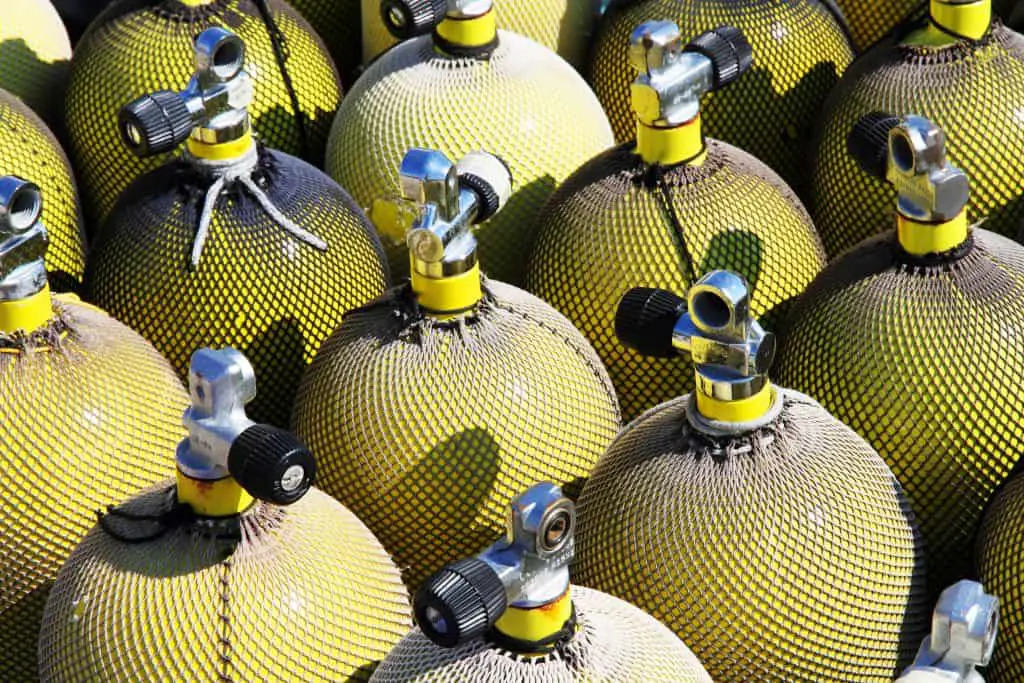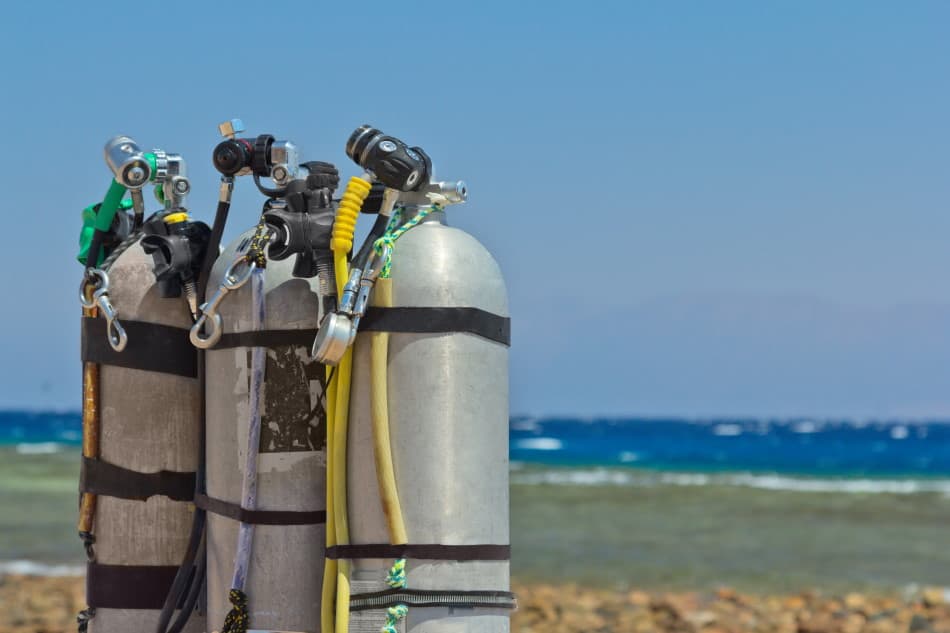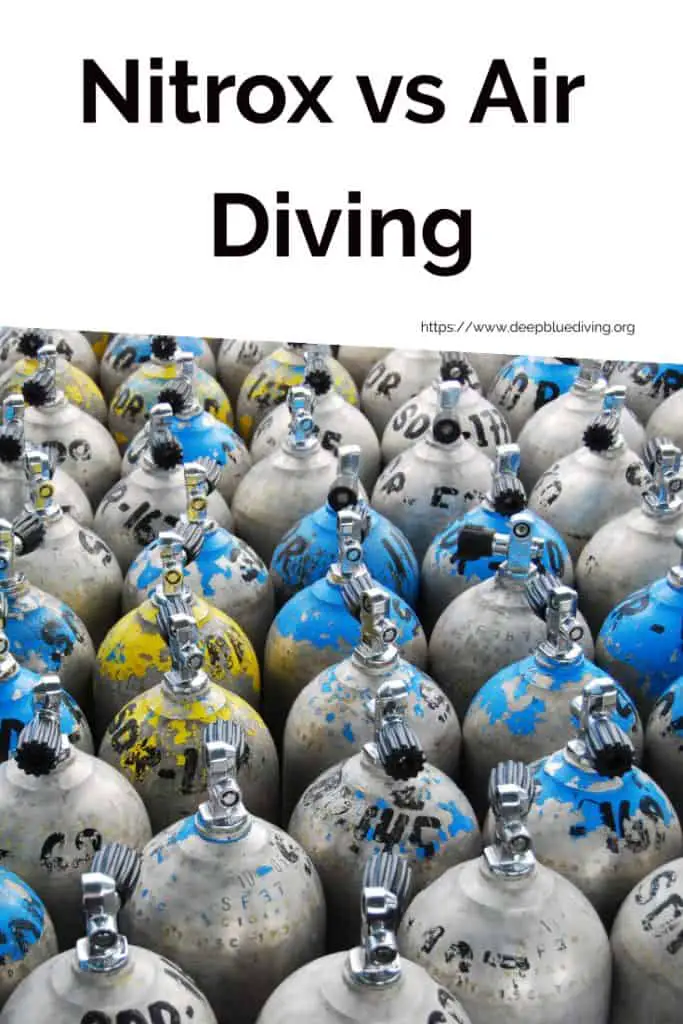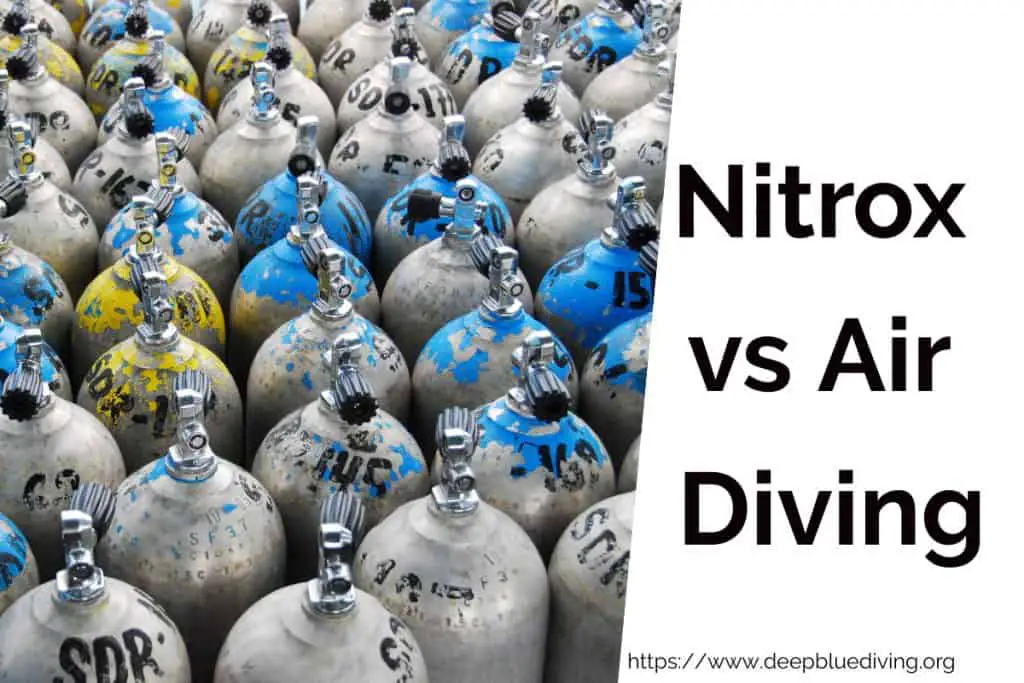Nitrox vs Air Diving – What you need to know!
Thinking about diving with Nitrox? Where is it better than air diving?
Or, to ask the better question. Is Nitrox diving better than diving with air?
Well, let’s have a look at diving with Nitrox vs Air and you can see for yourself what the benefits and downsides are!
What are the benefits of diving Nitrox?
Using Nitrox to scuba dive may help you reduce your decompression stress. Nitrox may also help you reduce the amount of nitrogen bubbles in your body after a dive. Nitrox also makes the de-gas process faster.
Nitrox also allows divers to stay at a depth for a longer period of time. This is especially beneficial for divers on liveaboards. They often dive three to four times a day.
Nitrox is also available for free on many liveaboards. You can find Nitrox mixes in varying concentrations. The most common mix contains 32% oxygen. This means that you can dive to a depth of 34 meters.
If you are a professional diver, you may want to consider diving with Nitrox. It may also be beneficial for divers with physical injuries. It will help them to reduce their no decompression limits.
Nitrox can reduce decompression stress at any depth. But it does not eliminate the risk of decompression sickness. It can however reduce the risk of nitrogen narcosis. The most common form of nitrogen narcosis is decompression sickness. You must still follow precautions to prevent DCS.
If you are planning a dive, it is important to ensure that you follow the correct surface intervals on your dive table. You must also ensure that you set a depth alarm on your dive computer to warn you if you exceed your depth limit. It is also important to get the proper training before you try diving with Nitrox.
Dangers of Diving with Nitrox
Unlike air, nitrox has a higher oxygen content, allowing divers to stay at depth for longer periods of time. Using nitrox requires additional training and certification. It’s also important to know how to use a nitrox dive table.
Nitrox is also used by technical divers to accelerate decompression. A diver can double the time he or she can spend at depth with nitrox. The risk of oxygen toxicity is reduced, but the oxygen concentration in the blood is increased. If the oxygen concentration is too high, a dive can become dangerous and even fatal. It can also cause visual distortions and convulsions.
Nitrox is also dangerous because it changes the way decompression works. Nitrox divers need to stop at 100 to 130 feet. If the dive is too deep, oxygen toxicity can occur. A diver may have a seizure, which can lead to drowning.
When divers use nitrox, they should have an oxygen analyzer with them. They should also use the table to determine their maximum operating depth and the oxygen limit. A divers normal no decompression limit is 56 minutes. However, when diving with nitrox, their no decompression limit can be extended to 40 minutes.
Nitrox has a lower nitrogen content than air. The higher water pressure dissolves more nitrogen. Nitrox is also more dangerous because it’s more volatile. When diving at shallow depths, nitrox divers may experience oxygen poisoning.
Nitrox is also more expensive than air. A dive shop may charge extra for service. When you buy a cylinder, the tag will show the oxygen content.

What are Pros and Cons of Diving with Enriched Air?
Using Enriched Air Nitrox is a great way to extend your dive time and get more out of your dive. It can reduce the risk of decompression sickness, or “the bends,” and also make you less fatigued after a dive. The increased oxygen content in Enriched Air Nitrox helps you absorb less nitrogen and reduce nitrogen accumulation in your body tissues.
You can get certified for enriched air diving in a short time. You can do this online or in person. You will be taught how to set up your dive computer for enriched air diving, how to analyze the oxygen content of your scuba tank, and how to manage your oxygen exposure. You will also learn about the risks of enriched air diving and how to minimize those risks. You can complete the Enriched Air Course in a half-day or a full day.
Enriched air nitrox is different from other common diving gas mixtures. You will need to know how to use it properly to avoid problems. The main benefit of using enriched air is that it reduces your decompression risk. When you dive using enriched air, you will spend less time at the surface and more time at the bottom. That means you will have more time to explore marine life and sunken wrecks.
The main concern of diving with enriched air is oxygen toxicity. You may develop symptoms of oxygen toxicity, including short-term memory loss, disorientation, joint pain, and extreme fatigue. Diving too deep or with too much nitrogen can also increase the risk of decompression sickness. If you are worried about your decompression safety, you can always talk to your dive shop or dive instructor.
How Deep Can you Dive With Nitrox?
Using Nitrox can allow divers to stay at depth longer than normal and increase the time spent underwater. It can also lower the risk of Decompression Sickness. However, nitrox diving is not without its own set of dangers. The main danger is Oxygen Toxicity. This is when the nitrogen in your scuba tank turns into a toxic gas that can cause convulsions, loss of consciousness, and drowning.
Nitrox is a gas mix that contains a higher percentage of oxygen than normal air. This means the mixture can be breathed at twice the pressure of 100% oxygen. However, it also means that there are higher concentrations of toxic gas at shallower depths. You should be aware of these dangers before using Nitrox.
Nitrox has a number of advantages, but you should always use it with caution. Using Nitrox can reduce your risk of DCI (Decompression Sickness) and DCS (Decompression Convulsions). However, it can also increase your risk of burning. If you do use Nitrox, make sure you use it at the right depth.
The National Oceanic and Atmospheric Administration (NOAA) recommends using a Nitrox blend with at least 32 percent oxygen. This can increase your depth limit to up to 112 feet. It can also allow you to dive to a depth of 28 metres.
Nitrox is not the only gas mix you can use. You can also use an enriched oxygen mix. These have depth limits based on the toxicity of the gas. The bottom line is that nitrox is not a good idea for beginners, but it is a logical step for experienced divers.

What Happens to Air when Scuba Diving
Using air when scuba diving is something that you have to learn to do. Air is a mixture of nitrogen and oxygen. The partial pressure of oxygen increases with depth.
You can increase your tolerance by repeatedly diving. You can also adjust your fin technique to reduce air consumption. This is the best way to get the most out of your dive. You can also bring bigger tanks.
If you have never dived in a while, you will use more air than most divers. This is because you will be breathing denser air. This means that you will need to breathe more slowly and deeply.
You will need to check your tank for leaks. You should also shake the tank to hear the water inside. If you find a leak, you will need to discard the tank.
When you’re scuba diving, you will need to keep yourself calm and cool. This will help you to avoid decompression sickness. When you become agitated, you will have higher heart rates and lose concentration.
The rate at which you breathe will also depend on your physical and mental state. If you’re cold or stressed, you will need to breathe more. You should also be mindful of your buoyancy control. If you are too heavy, you will need more air to reach neutral buoyancy.
You should also learn to stay calm at depth. You can do this by learning how to move through the water with fins.
Benefits of Diving Nitrox vs Air
Several benefits of diving Nitrox vs air are that divers can extend their bottom time and increase their decompression safety margin. However, before diving with Nitrox, divers need to understand the differences between breathing gas mixes and understand the risks of breathing high percentages of oxygen.
First, divers need to understand that Nitrox is a form of metabolizable gas that replaces nitrogen. Nitrogen can be toxic, and divers can experience decompression sickness (DCS) when they breathe too much.
Nitrox also helps to reduce the amount of nitrogen absorbed by the body. Divers using Nitrox can extend their bottom time and perform repetitive dives. Divers also report less fatigue after diving on Nitrox. This is important, because repetitive dives are especially interesting on liveaboards.
Nitrox has a limited amount of oxygen, but divers can increase the percentage of oxygen in the breathing gas. For example, a 50 percent Nitrox/80 percent oxygen mix is commonly used for deco stops. This mixture will be less effective than a 100 percent oxygen mixture. It also increases the risk of oxygen poisoning.
Aside from increasing your bottom time, divers can also do several dives in a day. Nitrox can increase the safety margin of your dive, which is important to plan your dives. The increased safety margin is especially important if you are diving deep.
The first thing divers need to do is find a dive shop that specializes in Nitrox. A Nitrox tank will have bright yellow or green bands on the tank. They should also have an oxygen analyzer. The gas analyzer will help to ensure the right amount of Nitrox in the tank.


